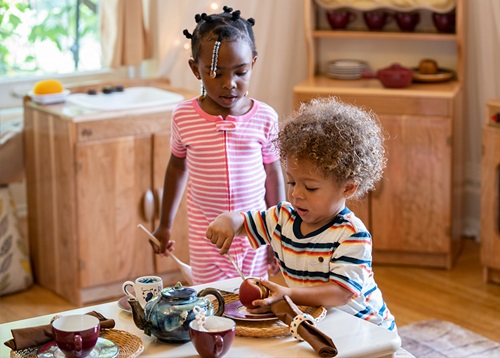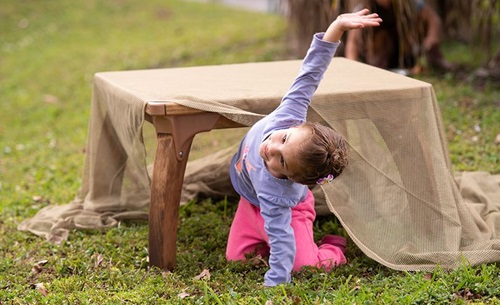Building Literacy with Lullabies
A Message from Two Grandmothers
| March 2016We have both worked in the early childhood profession in many capacities over the last 30 years and have children in their 40s. We wanted to share some of what we did, what we thought we knew, and where we have revised in our thinking. As our families are growing it remains our firm belief that nursery rhymes and lullabies are a must!
Infants are not born predisposed to speak or understand a certain language. They acquire their vocabulary from what they hear. Research shows a direct connection between the amount of words a young child hears and their future aptitude for learning. A now-famous 1995 research study found that low-income children were exposed to 30 million fewer words than their more fortunate peers by the age of three (Hart and Reisley 1995). Without doubt, this immense word gap places under-privileged children at a disadvantage before they even enter school. It also places a great responsibility on the adults who care for these children.
While this study proved to be ground-breaking, the science simply verified what mothers and grandmothers have instinctively known for generations. Young children need to be immersed into an environment of language in order to learn to communicate. Do you remember nursery rhymes from your childhood? Can you still recall the lullabies your mother or grandmother sang to you as a child? (They probably learned them from their mothers and grandmothers.) Do you think children today will have a comparable reserve of lullabies and nursery rhymes to recall from deep in their memories? Let's make sure they do because these repetitive songs can form a solid foundation for literacy in every child.
Beginning in Infancy
Babies need to be talked to, given time to respond, and responded to.
Senses are their windows to the world.
See me, hear me, feed me, touch me,
We are their guides/dance partners, our laps—their world
Feel me, stroke me, diaper me, know me.
Focused interactions throughout every day routines such as diapering or feeding, are a foundation of Magda Gerber's approach to caring for infants and toddlers (Gordon and Browne 2007). These are prime opportunities for talking or singing with children. Through the attachment process and responsive relationship infants learn about social interaction. The back-and-forth, imitative exchange between a caregiver and an infant is crucial to language development (Gonzalez-Mena and Eyer 2007). While our mothers and grandmothers didn’t know of Gerber’s work, they entertained us with nursery rhymes and songs during car rides, walks, and other everyday activities. Subconsciously, they were preparing us for our later mastery of reading skills.
For some people, talking to a baby is not natural or instinctive. However, we have discovered that talking to the baby using motherese, or child-directed speech, effects language development. Parents and child care providers often help infants’ master sounds by talking in this distinctive style. Adults speak slowly and with exaggerated changes in pitch and volume. This infant-directed speech attracts an infant’s attention with its slower pace and accentuated changes providing infants with increasingly more salient language clues. Infant directed speech includes especially good examples of vowels which may help infants learn to distinguish those sounds (Kail 2010). Newborns are biologically capable of hearing the entire range of phonemes—the unique sounds that can be joined together to create words in any language. As babies grow and are exposed to a particular language they begin to notice the linguistic distinctions that are meaningful and unique to that language.
At about two months of age infants begin to produce vowel-like sounds, such as “oooooo” or “aaaaaahhh,” a phenomenon known as cooing (Kail). After cooing comes babbling, a speech-like sound that has no meaning but sounds like a single syllable with a consonant and a vowel. Older infants begin to combine babbles to produce more complex sounds and later, the infant adds intonation. Babbling is not just mindless playing with sounds, instead it is a precursor to real speech and motherese helps children in this language process.
Surround Your Child with Language
These two grandmas are definitely right,
Surround your child day and night
In conversations, poetry, music, and song.
hey follow your word play, dancing, and singing along.
Poetry, nursery rhymes, and songs are a perfect match to supporting language development. The melody and cadence of the English language are deeply experienced in the sound and motion of these age old rhymes. Clearly the spirit and intention of traditional oral literature is kept alive through our use (Marino and Houlihan 1992). Whether we speak or sing the words with the correct tune, re-use a few favorite tunes, or make up our own, the connections we form with the child during these times are important.
The sounds a baby hears forms connections that grow stronger with repetition. When we sing or recite, “Baa, Baa, black sheep”, we begin the process of phonemic awareness. This strengthens the letter-sound connections that make it possible for children to master reading skills. Lullabies and spoken rhymes enhance the learning process by promoting phonological awareness and language development. Infants are pre-wired for language and music, including the capacity of a baby as young as one month to distinguish between the sounds “ba” and “pa” providing they receive adequate exposure (Doja 2014). This repetition must be worked into our programs so that children don’t lose this skill.
Perhaps one of the most important uses of lullabies is to sooth children before bedtime and or nap. As a result, the lullaby is often quite simple and repetitive. Lullabies can be found in many countries, and have existed since ancient times. Lullabies sung by parents and caregivers induce relaxation, rest, comfort, and optimal growth and development (Loewy and Stewart 2013). If we have many lullabies memorized, we can call upon them at will, catching the infant’s attention to help modulate their emotions, put them into a more restful state, or rouse them as needed.
Programs can and should have a file of these rhymes to call upon. The website http://www.lullaby-link.com/baby-lullabies.html has the words as well as demonstration of the tunes for those not familiar.
Conclusion
We cannot stress the importance of a language-rich environment for all infants, toddlers, and preschoolers. Infants and toddlers have the potential to constantly acquire new vocabulary through hearing words used in their environment. As care-givers we need to surround them with songs and poems. We can fill the “word gap” with the routine use of these developmentally appropriate nursery rhymes or repetitive lullabies. These have been handed down for generations. There is a reason that they have withstood the test of time. Take it from two grandmothers because “Grandma knows best!”
Bibliography
Birckmayer, J., A. Stonehouse. andA. Kennedy. 2008. From Lullabies, to Literature: Stories in the Lives of Infants and Toddlers. Washington D.C.: NAEYC
Christ, T, and C. Wang. 2010. “Research in Review. Bridging the Vocabulary Gap: What the Research Tells Us about Vocabulary Instruction in Early Childhood” Young Children. 65 (4).
Doja, A. 2014. “Socializing Enchantment: A Socio-Anthropological Approach to Infant-Directed Singing, Music Education and Cultural Socialization” International Review of the Aesthetics and Sociology of Music.45 (1), p. 120.
Fabes,R. and C.L.Martin. 2003. Exploring Child Development (2nd edition). Boston, MA: Allyn & Bacon Publishing.
Gordon, A. M. and K.W. Browne. 2007. Beginning essentials in early childhood education. Clifton Park, NY: Thomson Delmar Publishing
Gonzalez-Mena, J. and. D.W, Eyer. 2015. Infants, Toddlers, and Caregivers, a Curriculum of Respectful, Responsive, Relationship-Based Care and Education., New York, N.Y: McGraw-Hill
Hart, B., T.R. Reisley. 1995 Meaningful differences in the everyday experiences of young children. Baltimore M.D: Paul H. Brooks Publishing.
Kail, R.V. 2010. Children and their development (4th edition). Upper Saddle River, New Jersey: Pearson/Allyn & Bacon.
Loewy, J. and K. Stewart. 2013. “The Effects of Music Therapy on Vital Signs, Feeding, and Sleep in Premature Infants.” Pediatrics 131 (5), 902–18.
Marino, J., and D.F. Houlihan.1992 Mother Goose Time: Library Programs for Babies and their Caregivers. New York: The H. W. Wilson Co
Robbins-Wilson, A, 2008. Baby Lullabies in Alphabetical order. http://www.lullaby-link.com/baby-lullabies.html
Solomon, D. C. 2013. Baby Knows Best Raising a Confident and Resourceful Child, the RIE Way. New York, N.Y.: Little, Brown and Co
Trainor, L.J., C.D. Tsang,, V.H.W. Cheung. 2002 “Preference For Sensory Consonance in 2- and 4-month Old Infants.” Musical Perception: An Interdisciplinary Journal. 20 (2), 187–1.







